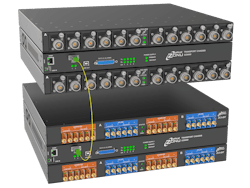Optical Zonu Releases Fault Detection and Localization for Its Network Management System
Optical Zonu Corporation has recently launched new fiber fault detection and localization features to its CloudView Network Management System (NMS) for the ZONUConnect base transceiver station (BTS) to distributed antenna system (DAS) fiber optic transport solution. These capabilities give telecommunication operators and enterprises improved visibility into RFoF network performance, as well as the ability to more hastily and correctly detect fiber fault locations to remediate network issues and, in turn, avoid downtime.
The platform has a proprietary micro optical time domain reflectometer (uOTDR) embedded in its pluggable modules to highlight fiber fault detection data within only a few meters. The latest upgrades to the CloudView NMS can now give a visual representation of the fiber pass on terrain maps and the OTDR data can be overlaid on the management panel, allowing operators to see fiber faults and reflection events with exact map locations.
“The growing reliance on high frequency over-the-air communication, such as 5G, has placed great importance on RFoF networks to transport these frequencies over long distances with no signal loss,” said Meir Bartur, co-founder and CEO of Optical Zonu. “By integrating ZONUConnect’s CloudView NMS with data from our innovative uOTDR modules, it is easier and quicker than ever before to install and maintain increasingly complex BTS to DAS connections and efficiently locate faults and other imperfections.”
“The NMS’s ability to provide visualization of preventive fiber events, such as connector or patch-panel imperfections, instead of only fiber breaks, is critical for solving issues that could render a RFoF network non-operational. Even with clean fiber connections, these components can introduce the same amount of loss as a kilometer or more of fiber. Locating these imperfections can help reduce total fiber loss and achieve better performance in a BTS to DAS link.”
